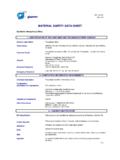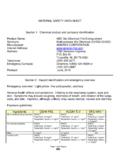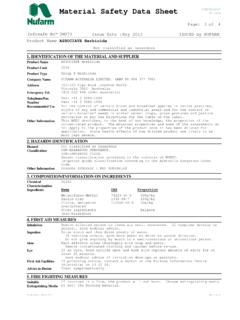Transcription of Material Safety Data Sheet - MSDS Touch Up Paint …
1 Not Products Limited,30 Hedgedale Road,Brampton, ONT L6T 5L2 Tel: (800) 263-7011 Fax: (800) Safety data Sheet - MSDSC ommon NameMaterial UsesManufactured forValidation DateIn Case of EmergencySection 1. Chemical Product and Company Identification:::: Touch Up PaintPart number:39225, 39226, 39227, 39228, 39229, 39231,39232, 39233, 39234, 39235, 39240, 39241,39242, 39243 CANUTEC (613) 996-6666:This Material is classified hazardous under the WHMIS Controlled Product Regulation in Hydroxide21645-51-21-3 Not 2. Composition, Information on IngredientsNameCAS #% by WeightUN numberSee Section 8 for Exposure Section 11 for Toxicological through skin. Dermal contact. Eye contact. Inhalation. OverviewSection 3. Hazards IdentificationRoutes of EntryPotential Acute Health EffectsHazardous in case of in case of eye contact (irritant).Not in case of skin contact (irritant). Non-sensitizer for skin. Skin inflammation is characterizedby itching, scaling, reddening, or, occasionally, State andAppearanceLiquid.
2 (Viscous liquid.)WARNING!CONTAINS Material WHICH CAUSES DAMAGE TO THE FOLLOWING ORGANS: BLOOD,KIDNEYS, LUNGS, LIVER, MUCOUS MEMBRANES, GASTROINTESTINAL TRACT, RESPIRATORYTRACT, SKIN, CENTRAL NERVOUS SYSTEM, EYE, LENS OR LIQUID AND MAY CAUSE FLASH BE HARMFUL IF INHALED, ABSORBED THROUGH SKIN OR CAUSE EYE AND SKIN CANCER HAZARDCONTAINS Material WHICH MAY CAUSE CANCER BASED ON ANIMAL of cancer depends on duration and level of exposure. Keep away from heat, sparks and contact with eyes, skin and clothing. Avoid prolonged contact with eyes, skin, and clothing. Do notingest. Avoid breathing vapor or mist. Keep container closed. Use only with adequate thoroughly after handling.:::::::Continued on Next PageTouch Up PaintPage: 2/6 CARCINOGENIC EFFECTS: Classified A4 (Not classifiable for human or animal.) by ACGIH, 3 (Notclassifiable for human.) by IARC [Xylene]. Classified None. by NIOSH [Titanium dioxide].
3 Classified A4(Not classifiable for human or animal.) by ACGIH, 3 (Not classifiable for human.) by IARC [Titaniumdioxide]. Classified A3 (Proven for animal.) by ACGIH, 2B (Possible for human.) by IARC[Ethylbenzene]. Classified None. by NIOSH [Ethylbenzene]. Classified 3 (Not classifiable for human.) byIARC [Synthetic amorphous silica, precipitated]. Classified A4 (Not classifiable for human or animal.) byACGIH, 3 (Not classifiable for human.) by IARC [Toluene].MUTAGENIC EFFECTS: Not EFFECTS: Not ConditionsAggravated byOverexposure:Repeated exposure to a highly toxic Material may produce general deterioration of health by anaccumulation in one or many human Chronic HealthEffectsSee Section 11 for more detailed information on health effects and symptoms.:::Do not induce vomiting unless directed to do so by medical personnel. Never give anything by mouth toan unconscious person. If large quantities of this Material are swallowed, call a physician for and remove any contact lenses.
4 In case of contact, immediately flush eyes with plenty ofwater for at least 15 minutes. Get medical case of contact, immediately flush skin with plenty of water. Remove contaminated clothing andshoes. Get medical inhaled, remove to fresh air. If not breathing, give artificial respiration. If breathing is difficult, giveoxygen. Get medical 4. First Aid MeasuresEye ContactSkin ContactInhalationIngestionNo specific antidote. Medical staff must contact Poison Information to Physician:::::The lowest known value is to C ( to F) (Ethylbenzene). products are carbon oxides (CO, CO2). Some metallic cup: 23 C ( F). (Setaflash.)LOWER: FIRE: Use dry chemical FIRE: Use water spray or fog. Never direct a water jet in the container in order to prevent anysplashing of the product which could cause spreading of the fire. Cool containing vessels with water jetin order to prevent pressure build-up, autoignition or flammable in presence of open flames, sparks and static in presence of of explosion of the product in presence of mechanical impact: Not of explosion of the product in presence of static discharge: Not 5.
5 Fire Fighting MeasuresFlammability of the ProductAuto-ignition TemperatureFlash PointsFlammable LimitsProducts of CombustionFire Hazards in Presence ofVarious SubstancesExplosion Hazards inPresence of VariousSubstancesFire Fighting Mediaand InstructionsSpecial Remarks on FireHazardsBe sure to use an approved/certified respirator or Clothing (Fire)::::::::::Absorb with an inert Material and put the spilled Material in an appropriate waste away from heat. Keep away from sources of ignition. Stop leak if without risk. Absorb with dryearth, sand or other non-combustible Material . Do not get water inside container. Do not Touch spilledmaterial. Prevent entry into sewers, basements or confined areas; dike if needed. Call for assistance 6. Accidental Release MeasuresSmall Spill and LeakLarge Spill and Leak::Continued on Next PageTouch Up PaintPage: 3/6 Store in a segregated and approved area. Keep container in a cool, well-ventilated area.
6 Keepcontainer tightly closed and sealed until ready for use. Avoid all possible sources of ignition (spark orflame).Keep away from heat, sparks and flame. Keep container closed. Use only with adequate ventilation. Toavoid fire or explosion, dissipate static electricity during transfer by grounding and bonding containersand equipment before transferring Material . Use explosion-proof electrical (ventilating, lighting andmaterial handling) 7. Handling and StorageHandlingStorage::Provide exhaust ventilation or other engineering controls to keep the airborne concentrations of vaporsbelow their respective occupational exposure limits. Ensure that eyewash stations and Safety showersare proximal to the work-station goggles. Full suit. Vapor respirator. Boots. Gloves. A self-contained breathing apparatusshould be used to avoid inhalation of the product. Suggested protective clothing might not be sufficient;consult a specialist before handling this (Canada).
7 TLV: 100 ppmRSST (Canada). TLV: 100 ppm STEL: 150 ppm 15 minute(s). TLV: 434 mg/m3 STEL: 651 mg/m3 15 minute(s).Aluminum HydroxideACGIH TLV (Canada, 2003). TWA: 2 mg/m3 8 hour(s). Form: SolubleTolueneACGIH TLV (Canada, 2000). Skin TWA: 188 mg/m3 8 hour(s). TWA: 50 ppm 8 hour(s). TWA: 188 mg/m3 8 hour(s). TWA: 50 ppm 8 hour(s).Section 8. Exposure Controls, Personal ProtectionEngineering ControlsPersonal Protection in Caseof a Large SpillProduct NameExposure LimitsVapor respirator. Be sure to use an approved/certified respirator or equivalent. Wear appropriaterespirator when ventilation is ProtectionEyesBodyRespiratoryHandsFeetPr otective Clothing(Pictograms)Consult local authorities for acceptable exposure limits.::::::::Exposure LimitsWeighted average: C ( F)Liquid. (Viscous liquid.)Not average: C ( F) (Water = 1)Weighted average: kPa ( mm Hg) (at 20 C)Not (Strong.)Not PointMelting/Freezing PointSection 9.
8 Physical and Chemical PropertiesPhysical State andAppearanceMolecular WeightpH (1% Soln/Water)Specific GravityVapor PressureOdorColorNot Formula::::::::::Continued on Next PageTouch Up PaintPage: 4 (v/v).Weighted average: (Air = 1)Not soluble in diethyl in cold water, hot average: ppm<1 compared to Butyl DensityVolatilityOdor ThresholdEvaporation RateViscosityLogKowSolubility62 (%)VOC::::::::The product is with oxidizing not 10. Stability and ReactivityStability and ReactivityConditions of InstabilityIncompatibility withVarious SubstancesHazardous DecompositionProductsHazardous Polymerization:::::Hazardous in case of skin contact (irritant), of eye contact (irritant), of for EFFECTS: Classified A4 (Not classifiable for human or animal.) by ACGIH, 3 (Notclassifiable for human.) by IARC [Xylene]. Classified None. by NIOSH [Titanium dioxide]. Classified A4(Not classifiable for human or animal.)
9 By ACGIH, 3 (Not classifiable for human.) by IARC [Titaniumdioxide]. Classified A3 (Proven for animal.) by ACGIH, 2B (Possible for human.) by IARC[Ethylbenzene]. Classified None. by NIOSH [Ethylbenzene]. Classified 3 (Not classifiable for human.) byIARC [Synthetic amorphous silica, precipitated]. Classified A4 (Not classifiable for human or animal.) byACGIH, 3 (Not classifiable for human.) by IARC [Toluene].Contains Material which causes damage to the following organs: blood, kidneys, lungs, liver, mucousmembranes, gastrointestinal tract, upper respiratory tract, skin, central nervous system (CNS), eye, lensor 11. Toxicological InformationChronic Effects on HumansOther Toxic Effects onHumansSpecial Remarks on Toxicityto AnimalsSpecial Remarks on ChronicEffects on HumansSpecial Remarks on OtherToxic Effects on Humans:::::Toxicity DataIngredient NameXyleneLD50LD50LD50LD50LC504300 mg/kg2119 mg/kg4300 mg/kg>1700 mg/kg6350 ppm (4 hour(s))OralOralOralDermalInhalationRatM ouseMammalRabbitRatEthylbenzeneLD503500 mg/kgOralRat4-Hydroxy-4-methyl-2-pentano neLD50LD50LD502520 mg/kg3950 mg/kg13500 mg/kgOralOralDermalRatMouseRabbitTrimeth ylbenzeneLD50LC508970 mg/kg18 mg/m3 (4 hour(s))OralInhalationRatRatTolueneLD50L D50636 mg/kg1221 mg/kgOralDermalRatRabbitTestResultRouteS peciesContinued on Next PageTouch Up PaintPage: 5/6 Not products are carbon oxides (CO, CO2) and water.
10 Some metallic products of degradation are less toxic than the product 12. Ecological InformationBOD and CODB iodegradable/OECDT oxicity of the Products ofBiodegradationSpecial Remarks on theProducts of BiodegradationNot of Degradation::::::Ecotoxicity DataXyleneOncorhynchus mykiss (LC50)Oncorhynchus mykiss (LC50)Lepomis macrochirus (LC50)Lepomis macrochirus (LC50)Lepomis macrochirus (LC50)Pimephales promelas (LC50)96 hour(s)96 hour(s)96 hour(s)96 hour(s)96 hour(s)96 hour(s) mg/l12 mg/lEthylbenzeneDaphnia magna (EC50)Daphnia magna (EC50)Selenastrum capricornutum (EC50)Oncorhynchus mykiss (LC50)Pimephales promelas (LC50)Poecilia reticulata (LC50)48 hour(s)48 hour(s)48 hour(s)96 hour(s)96 hour(s)96 hour(s) mg/l4-Hydroxy-4-methyl-2-pentanoneLepomi s macrochirus (LC50)96 hour(s)420 mg/lTrimethylbenzenePimephales promelas (LC50)96 hour(s) mg/lTolueneDaphnia magna (EC50)Daphnia magna (EC50)Oncorhynchus mykiss (EC50)Oncorhynchus mykiss (LC50)Oncorhynchus mykiss (LC50)Pimephales promelas (LC50)48 hour(s)48 hour(s)48 hour(s)96 hour(s)96 hour(s)96 hour(s)





